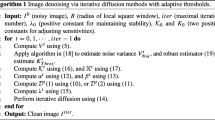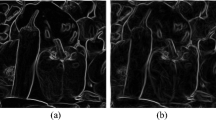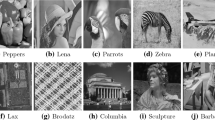Abstract
A crucial aspect of contemporary image processing systems is image denoising. The anisotropic diffusion function is a feature of the partial differential equation employed for the purpose of noise reduction and the preservation of image characteristics such as edges. A new tangent sigmoid diffusion coefficient and a new adaptive threshold parameter have been proposed in this work, which leads to faster convergence. In comparison to traditional anisotropic diffusion model techniques, the proposed technique performs admirably. As evidenced by the results, which demonstrate that the new anisotropic diffusion technique is not only capable of efficiently removing noise, but also of maintaining content in the denoised image. The performance of the proposed method is evaluated using various metrics, including peak signal-to-noise ratio, convergence rate, structural similarity index, time complexity, and space complexity. When comparing the proposed approach to previous methods, it is evident that the proposed method outperforms in various aspects. These include a higher convergence rate (− 0.1278), a greater peak signal-to-noise ratio (37.9827 dB), a higher structural similarity index (0.97432), a lower time complexity (5.72 s), and a smaller space complexity (15.6 KB).






















Similar content being viewed by others
Explore related subjects
Discover the latest articles, news and stories from top researchers in related subjects.Data availability
The datasets generated during and/or analyzed during the current study are available in the [SIPI Image Database, BRATS2020 database] repository, [https://sipi.usc.edu/database/database.php?volume=misc, https://www.med.upenn.edu/cbica/brats2020/data.htm].
References
Benhamouda B, Weickert J (1997) A semidiscrete nonlinear scale-space theory and its relation to the Perona—Malik paradox. Adv Comput vis. https://doi.org/10.1007/978-3-7091-6867-7_1
Bhupendra G, Lamba SS (2021) An efficient anisotropic diffusion model for image denoising with edge preservation. Comput Math Appl 93:106–119. https://doi.org/10.1016/j.camwa.2021.03.029
Black MJ, Sapiro G, Marimont DH, Heeger D (1998) Robust anisotropic diffusion. IEEE Trans Image Process 7(3):421–432. https://doi.org/10.1109/83.661192
BRATS2020 database. https://www.med.upenn.edu/cbica/brats2020/data.htm. Accessed 23 Aug 2023
Chen Y, He T (2021) Image denoising via an adaptive weighted anisotropic diffusion. Multidimen Syst Signal Process 32:651–669. https://doi.org/10.1007/s11045-020-00760-x
Dhabal S, Chakrabarti R, Mishra NS, Venkateswaran P (2021) An improved image denoising technique using differential evolution-based salp swarm algorithm. Soft Comput 25(3):1941–1961. https://doi.org/10.1007/s00500-020-05267-y
Figshare database (2023) https://figshare.com/articles/dataset/brain_tumor_dataset/1512427. Accessed 23 Aug 2023
Francine C, Morel JM, Alvarez L, Lions PL (1992) Image selective smoothing and edge detection by nonlinear diffusion. SIAM J Numer Anal 29(3):845–866. https://doi.org/10.1137/0729052
Goyal B, Dogra A, Sangaiah AK (2022) An effective nonlocal means image denoising framework based on non-subsampled Shearlet transform. Soft Comput. https://doi.org/10.1007/s00500-022-06845-y
Grazzini J, Turiel A, Yahia H (2005). Presegmentation of high-resolution satellite images with a multifractal reconstruction scheme based on an entropy criterium. In: IEEE intern confer image process, vol 1, pp 1–4. https://doi.org/10.1109/ICIP.2005.1529834
Guo J, Wang YQ, Chen W, Zhang W (2013) Image denoising using modified Perona–Malik model based on directional Laplacian. Signal Process 93(9):2548–2558. https://doi.org/10.1016/j.sigpro.2013.02.020
Knaus C, Zwicker M (2014) Progressive image denoising. IEEE Trans Image Process 23(7):3114–3125. https://doi.org/10.1109/TIP.2014.2326771
Koenderink J (1984) The structure of images. Biol Cybern 50(5):363–370. https://doi.org/10.1007/BF00336961
Kollem S, Ramalinga Reddy K, Srinivasa Rao D, Rajendra Prasad C, Malathy V, Ajayan J, Muchahary D (2022) Image denoising for magnetic resonance imaging medical images using improved generalized cross-validation based on the diffusivity function. Int J Imaging Syst Tech 32(4):1263–1285. https://doi.org/10.1002/ima.22681
Kollem S, Reddy KR, Duggirala S (2023) A novel diffusivity function-based image denoising for MRI medical images. Multimed Tool Appl 82:32057–32089. https://doi.org/10.1007/s11042-023-14457-3
Li W, Li Q, Gong W, Tang S (2012) Total variation blind deconvolution employing split Bregman iteration. J vis Commun Image Represent 23(3):409–417. https://doi.org/10.1016/j.jvcir.2011.12.003
Monteil J, Beghdadi A (1999) A new interpretation and improvement of the nonlinear anisotropic diffusion for image enhancement. IEEE Trans Pattern Anal Mach Intell 21(9):940–946. https://doi.org/10.1109/34.790435
Nieminen A, Heinonen P, Neuvo Y (1987) A new class of detail-preserving filters for image processing. IEEE Trans Pattern Anal Mach Intell 1:74–90. https://doi.org/10.1109/TPAMI.1987.4767873
Perona P, Malik J (1990) Scale-space and edge detection using anisotropic diffusion. IEEE Trans Pattern Anal Mach Intell 12(7):629–639. https://doi.org/10.1109/34.56205
Qi H, Tan S, Li Z (2022) Anisotropic weighted total variation feature fusion network for remote sensing image denoising. Remote Sens 14(24):6300. https://doi.org/10.3390/rs14246300
Rafsanjani HK, Sedaaghi MH, Saryazdi S (2017) An adaptive diffusion coefficient selection for image denoising. Digit Signal Process 64:71–82. https://doi.org/10.1016/j.dsp.2017.02.004
Ren W, Wang Y, Wang H (2013) Anisotropic second and fourth-order diffusion models based on convolutional virtual electric field for image denoising. Comput Math Appl 66(10):1729–1742. https://doi.org/10.1016/j.camwa.2013.08.034
Rudin LI, Osher S, Fatemi E (1992) Nonlinear total variation-based noise removal algorithms. Phys D Nonlinear Phenom 60(1–4):259–268. https://doi.org/10.1016/0167-2789(92)90242-F
SIPI Image Database (2023). https://sipi.usc.edu/database/database.php?volume=misc. Accessed 22 Aug 2023
Tebini S, Mbarki Z, Seddik H, Braiek EB (2016a) Rapid and efficient image restoration technique based on new adaptive anisotropic diffusion function. Digit Sig Process 48:201–215. https://doi.org/10.1016/j.dsp.2015.09.013
Tebini S, Seddik H, Braiek EB (2016b) An advanced and adaptive mathematical function for an efficient anisotropic image filtering. Comput Math Appl 72(5):1369–1385. https://doi.org/10.1016/j.camwa.2016.07.004
Tsai DM, Chao SM (2005) An anisotropic diffusion-based defect detection for sputtered surfaces with inhomogeneous textures. Image vis Comput 23(3):325–338. https://doi.org/10.1016/j.imavis.2004.09.003
Tsiotsios C, Petrou M (2013) On the choice of the parameters for anisotropic diffusion in image processing. Pattern Recogn 46(5):1369–1381. https://doi.org/10.1016/j.patcog.2012.11.012
Vasu GT, Palanisamy P (2022) Multi-focus image fusion using an anisotropic diffusion filter. Soft Comput 26(24):14029–14040. https://doi.org/10.1007/s00500-022-07562-2
Vasu GT, Palanisamy P (2023) CT and MRI multi-modal medical image fusion using weight-optimized anisotropic diffusion filtering. Soft Comput 27(13):9105–9117. https://doi.org/10.1007/s00500-023-08419-y
Wang Y, Chen W, Zhou S, Yu T, Zhang Y (2011) MTV: modified total variation model for image noise removal. Electron Lett 47(10):592–594
Wang H, Wang Y, Ren W (2012) Image denoising using anisotropic second and fourth-order diffusions based on gradient vector convolution. Comput Sci Inf Syst 9(4):1493–1511. https://doi.org/10.2298/CSIS120219060W
Wang N, Shang Y, Chen Y, Yang M, Zhang Q, Liu Y, Gui Z (2018) A hybrid model for image denoising combining modified isotropic diffusion model and modified Perona–Malik model. IEEE Access 6:33568–33582. https://doi.org/10.1109/ACCESS.2018.2844163
Wang W, Wang Y, Wu Y, Lin T, Li S, Chen B (2019) Quantification of full left ventricular metrics via deep regression learning with contour-guidance. IEEE Access 7:47918–47928. https://doi.org/10.1109/ACCESS.2019.2907564
Wei GW (1999) Generalized Perona–Malik equation for image restoration. IEEE Sigl Process Lett 6(7):165–167. https://doi.org/10.1109/97.769359
Wielgus M (2014) Perona–Malik equation and its numerical properties. arXiv:1412.6291
Zhang Z, Duan C, Lin T, Zhou S, Wang Y, Gao X (2020) GVFOM: a novel external force for active contour-based image segmentation. Inf Sci 506:1–18. https://doi.org/10.1016/j.ins.2019.08.003
Funding
The authors declare that no funds, grants, or other support were received during the preparation of this manuscript.
Author information
Authors and Affiliations
Contributions
All authors contributed equally to the study conception, design, analysis and manuscript preparation. All authors read and approved the final manuscript.
Corresponding author
Ethics declarations
Conflict of interest
The authors declare that they have no conflict of interest.
Ethical approval
This article does not contain any studies with human participants or animals performed by any of the authors.
Additional information
Publisher's Note
Springer Nature remains neutral with regard to jurisdictional claims in published maps and institutional affiliations.
Rights and permissions
Springer Nature or its licensor (e.g. a society or other partner) holds exclusive rights to this article under a publishing agreement with the author(s) or other rightsholder(s); author self-archiving of the accepted manuscript version of this article is solely governed by the terms of such publishing agreement and applicable law.
About this article
Cite this article
Kollem, S. A fast computational technique based on a novel tangent sigmoid anisotropic diffusion function for image-denoising. Soft Comput 28, 7501–7526 (2024). https://doi.org/10.1007/s00500-024-09628-9
Accepted:
Published:
Issue Date:
DOI: https://doi.org/10.1007/s00500-024-09628-9




